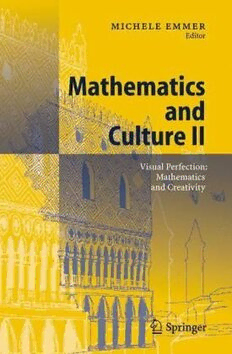Table Of ContentMathematics
and Culture II
MicheleEmmer
Mathematics
and Culture II
Visual Perfection:
Mathematics and Creativity
Editor
MicheleEmmer
DipartimentodiMatematica“G.Castelnuovo”
UniversitàdegliStudi“LaSapienza”,Roma,Italy
PiazzaleAldoMoro 2
00185Roma,Italy
e-mail:[email protected]
Library ofCongress ControlNumber: 2003064905
Acatalog recordfor this bookis availablefrom theLibrary ofCongress.
Bibliographicinformationpublishedby DieDeutscheBibliothek
DieDeutscheBibliotheklists this publicationin theDeutscheNationalbibliografie;
detailedbibliographicdatais availablein theInternet at <http://dnb.ddb.de>.
ThearticlesbyApostolosDoxiadisEuclid’sPoetics:Anexaminationofthesimilaritybetweennar-
rativeandproof,SimonSinghTheRiseofNarrativeNon-FictionandRobertOssermanMathe-
maticsTakesCenterStagewereoriginallypublishedinItalianinMatematicaeCultura2002,
88-470-0154-4bySpringerItalia,Milano2002.
The Articles Mathematics and Culture: Ever New Ideas; Mathematics, Art and Architecture;
Mathland: From Topology to Virtual Architecture; Mathematics, Literature and Cinema and
MathematicsandRaymondQueneaubyMicheleEmmerweretranslatedfromtheItalianLan-
guagebyGianfrancoMarletta.
e-mail:[email protected]
Mathematics Subject Classification(2000): 00Axx, 00B10, 01-XX
ISBN 3-540-21368-6 Springer BerlinHeidelbergNew York
Thisworkissubjecttocopyright.Allrightsarereserved,whetherthewholeorpartofthemate-
rialisconcerned,specificallytherightsoftranslation,reprinting,reuseofillustrations,recita-
tion,broadcasting,reproductiononmicrofilmorinanyotherway,andstorageindatabanks.
Duplicationofthispublicationorpartsthereofispermittedonlyundertheprovisionsofthe
GermanCopyrightLawofSeptember9,1965,initscurrentversion,andpermissionforusemust
always be obtained from Springer. Violations are liable for prosecution under the German
Copyright Law.
Springer is apart ofSpringer Science+Business Media
springeronline.com
©Springer-VerlagBerlinHeidelberg 2005
PrintedinGermany
Theuseofgeneraldescriptivenames,registerednames,trademarks,etc.inthispublication
doesnotimply,evenintheabsenceofaspecificstatement,thatsuchnamesareexemptfromthe
relevant protectivelaws and regulations and thereforefreefor general use.
EngravingoncoverandpartbeginningsbyMatteoEmmer, fromthebook:M.Emmer “La
Veneziaperfetta”,CentroInternazionaledellaGrafica,Venezia, 2003; by kindpermission.
Typeset:performelectronicpublishingGmbH,Heidelberg
Cover design:ErichKirchner,Heidelberg
Production:LE-TEXJelonek,Schmidt &Vöckler GbR,Leipzig
Printedonacid-freepaper 46/3142/YL-54 3 2 1 0
Mathematics andCulture:EverNew Ideas
MicheleEmmer
Oneoftheinterestingquestionsinthestudyoflinksbetweenmathematics,art
andcreativityiswhetheramathematician’screativityleadshimtoinventanew
world,orrathermakeshimdiscoveronethatalreadyexistsinitsownright.It
could seem like a superfluous question of very little interest. Though it might
seemsotononmathematicians,itcertainlyisn’tsoformanymathematicianslike
RogerPenrose,whohasdedicatedapartofthebookTheEmperor’sNewMind[1]
tothissubject.“Inmathematics,shouldonetalkofinventionorofdiscovery?”
asks Roger Penrose. There are two possible answers to the question: when the
mathematicianobtainsnewresults,hecreatesonlysomeelaboratementalcon-
structionswhich,althoughhavenorelationtophysicalrealitywhatsoever,never-
thelesspossesssuchpowerandelegancethattheyareabletomaketheresearcher
believethatthese“merementalconstructions”havetheirveryownreality.Alter-
V
natively,domathematiciansdiscoverthat“thesemerementalconstructions”are
alreadythere,atruthwhoseexistenceiscompletelyindependentoftheirwork-
ings out? Penrose is inclined toward the second point of view, even though he
addsthattheproblemisnotassimpleasitseems.Hisopinionisthatinmathe-
maticsonedeterminessituationsforwhichthetermdiscoveryiscertainlymore
appropriatethantheterminvention.Therearecasesinwhichtheresultsessen-
tially derive from the structure itself, more than from the input of mathemati-
cians.Penrosecitestheexampleofcomplexnumbers:“Laterwefindmanyother
magicalpropertiesthatthesecomplexnumberspossess,propertiesthatwehad
noinklingaboutatfirst.Thesepropertiesarejustthere.Theywerenotputthere
byCardano,norbyBombelli,norWallis,norCoates,norEuler,norWessel,nor
Gauss,despitetheundoubtedfarsightednessofthese,andother,greatmathema-
ticians;suchmagicwasinherentintheverystructurethattheygraduallyuncov-
ered.”
When mathematicians discover a structure of this kind, it means that they
stumbleduponthatwhichPenrosecalls“worksofGod”.So,aremathematicians
mereexplorers?Fortunatelynotallmathematicalstructuresaresostrictlyprede-
termined.Therearecasesinwhich“theresultsareobtainedequallybymeritof
thestructureandofthemathematicians’calculations”;inthiscase,Penrosesays,
itismoreappropriatetousethewordinventionthantheworddiscovery.Hence
thereisroomforwhathecallsworksofman,thoughhenotesthatthediscoveries
of structures that are works of God are of vastly greater importance than the
‘mere’ inventions that are the works ofman.
Mathematics andCultureII
One can make analogous distinctions in the arts and in engineering. “Great
works ofart areindeed‘closer toGod’ thanarelesser ones.”
Amongartists,Penroseclaims,theideathattheirmostimportantworksreveal
eternaltruthsisnotuncommon,thattheyhave“somekindofprioretherealexis-
tence”,whilethelesserimportantworkshaveamorepersonalcharacter,andare
arbitrary,mortalconstructions.Inmathematics,thisneedtobelieveinanimma-
terialandeternalexistence,atleastofthemostprofoundmathematicalconcepts
(theworksofGod),isfeltevenmorestrongly.Penroseobservesthat“thereisa
compellinguniquenessanduniversalityinsuchmathematicalideaswhichseems
tobeofquiteadifferentorderfromthatwhichonecouldexpectintheartsoror
engineering.”Aworkofartcanbeappreciatedorbroughtintoquestionindiffer-
entepochs,butno-onecanputindoubtacorrectproofofamathematicalresult.
Penroseexplainsveryexplicitlythatmathematiciansthinkoftheirdiscipline
asahighlycreativeactivitythathasnothingtoenvyofthecreativityofartistsand
indeed,becauseoftheuniquenessanduniversalityofmathematicalcreation,one
that should be regarded as superior to the artistic discipline; Penrose doesn’t
writeitexplicitly,butmanymathematiciansthinkthatmathematicsisthetrue
Art; a difficult, laborious art, with it’s very own language and symbolism, that
produces universally accepted results.
Penrosetakesupthequestionoftheexistenceinitsownrightoftheworldof
mathematicalideas,aquestionthathasdoggedthescienceofmathematicssince
itsinception.ItcomesfromthebookMatièreàpensée,co-authoredbyamathe-
matician,AlainConnes,winneroftheFieldsmedal,andaneurobiologist,Jean-
VI
PierreChangeux [2].
In one of the chapters in the book, entitled Invention ou découverte the
neurobiologist,speakingofthenatureofmathematicalobjects,recallsthatthere
isarealistattitudedirectlyinspiredbyPlato,anattitudethatcanbesummarised
inthephrase:theworldispopulatedbyideasthathavearealityseparatefrom
physicalreality.Supportinghisobservation,ChangeuxquotesaclaimofDieu-
donné, according to whom “mathematicians accept that mathematical objects
possessarealitydistinctfromphysicalreality”,arealitythatcanbecomparedto
thatwhichPlatoaccordstohisIdeas.Fromthispointofviewitisofsecondaryim-
portancewhetherornotthemathematicalworldisadivinecreation,asthemath-
ematicianCantor(1874–1918)believed:“ThehighestperfectionofGodisthepos-
sibility ofcreatinganinfinite set,andhis immensebounty leads him todo so.”
Weareincompletedivinemathesis,incompletemetaphysics.Thisissurpris-
ingtoseriousscientists,commentsChangeux.Connes,themathematician,notat
all bothered by the biologist’s arguments, replies very clearly that he identifies
strongly with the realist point of view. After emphasising that the sequence of
primenumbershasamorestablerealitythanthematerialrealitysurroundingus,
he notes that “one can comparethe workof a mathematicianto that of an ex-
plorerdiscoveringthe world.” If practicalexperience leads usto discoverpure
andsimplefactssuchas,forexample,thatthesequenceofprimenumbersappear
tohavenoend,theworkofamathematicianconsistsofprovingthatthereexists
aninfinitenumberofprimes.Oncethispropertyhasbeenproved,no-onecan
everclaimtohavingfoundthelargestprimeofall.Itwouldbeeasytoshowthem
Preface
thattheyarewrong.Connesconcludes“soweclashwitharealityjustasincon-
testableasthephysicalone”.Indeed,itisarguablymorerealthananyphysicalre-
ality.
Stillintheaforementionedbook,wereadthatmathematicsisauniversallan-
guage,butthatisnotall,forthegenerativenatureofmathematicshasacrucial
role.Otherwiseonecouldnotexplaintheincredibleandunforeseeableusefulness
ofmathematics,frommeteorologytothestructureofDNA,tothesimulationof
boats for theAmerica’s Cup.
Imaginationisnotenoughtodomathematics;youneedknowledgeofthelan-
guageandtechniques;imagination,creativity,theabilitytomakeproblemsex-
plicit, toformaliseand solve them, whenever possible.
Inrecentyears,thankstotheadventofcomputergraphics,theroleofvisuali-
sationinsomesectorsofmathematicshasincreasedsignificantly.Itwasinevita-
blethatthissortofnewVisualMathematicswouldopennewwaysforlinksbe-
tween creativity in the arts and in mathematics. We wish to deal with some of
theseaspectsinthisnewbookoftheseriescalledsignificantly“Mathematicsand
Culture”,whichwasbornofanideaofValeriaMarchiafavaandMicheleEmmer
inSeptember 1997,inTurin.
References
VII
[1] Penrose,R.:TheEmperor’s New Mind.OxfordUniversity Press,New York(1989).
[2] Changeux,Je.-P.,Connes,A.:MatièreàPenseée.ed.OdileJacob,Paris (1989).
TableofContents
Mathematics,Art andArchitecture
Mathematics,Art andArchitecture
MicheleEmmer .............................................................................................. 3
From Tiling the Plane to Paving Town Square
JudithFlaggMoranandKimWilliams......................................................... 5
Mathematics inContemporary Arts –FiniteandInfinity
DietmarGuderian.......................................................................................... 23
DeInsanaGeometria
AchillePerilli.................................................................................................. 39
Ovals inBorromini’s Geometry
MicheaSimona............................................................................................... 45
Fractals:AResonancebetweenArt andNature
IX
RichardTaylor,BenNewell,BrankaSpeharandColinClifford.................. 53
Mathland–FromTopology toVirtualArchitecture
MicheleEmmer .............................................................................................. 65
VisualMathematics andComputerGraphics
Introduction:VisualMathematics andComputer Graphics
MicheleEmmer............................................................................................... 81
MathAwareness Month 2000:AnInteractiveExperience
ThomasF.BanchoffandDavideP.Cervone................................................. 83
VisualTopology andVariationalProblems
onTwo-DimensionalSurfaces
AnatolyT.Fomenko,AlexandrO.IvanovandAlexeyA.Tuzhilin ............. 99
MetarealisticRenderingofReal-timeInteractive
Computer Animations
GeorgeK.Francis............................................................................................ 125
VirtualSculptures
HerbertW.Franke.......................................................................................... 145
PublicationofElectronicGeometry Models
MichaelJoswigandKonradPolthier ............................................................ 151
Trees,Roots andaBrain:
AMethaphoricalFoundationfor MathematicalArt
JohnSims ........................................................................................................ 163
TableofContents
Mathematics,LiteratureandCinema
Mathematics,LiteratureandCinema
MicheleEmmer .............................................................................................. 173
Euclid’sPoetics:Anexaminationofthesimilarity
betweennarrativeandproof
ApostolosDoxiadis......................................................................................... 175
TheRiseofNarrativeNon-Fiction
SimonSingh.................................................................................................... 183
MathematicsTakesCenterStage
RobertOsserman............................................................................................ 187
Mathematics andRaymondQueneau
MicheleEmmer .............................................................................................. 195
Authors ............................................................................................................... 201
X
Mathematics, Art
and Architecture
Mathematics,Art andArchitecture
MicheleEmmer
Thecarethatmathematicianshavefortheaestheticqualityoftheirdisciplineis
noteworthy:thisgivesrisetomanymathematicians’ideathatmathematicalac-
tivity andartisticactivity are,in some sense, very similar andcomparable.
MorrisKline,amathematician,(andheisbutoneofmanyexamplesthatwe
couldcite)hasdedicatedseveralpagesofhisbookMathematicsInWesternCul-
ture[1]tothissubject.Afterrecallingthatmathematicianshaveforhundredsof
yearsacceptedwhattheGreeksmaintained,thatis,thefactthatmathematicsis
an art and that mathematical work must satisfy aesthetic requirements, Kline
asksthefundamentalquestionofwhymanypeoplemaintainthattheinclusionof
mathematics in thearts is unjustified.
Oneofthemostcommonobjectionsisthatmathematicsdoesnotevokeany
emotion.Kline,ontheotherhand,observesthatmathematicsprovokesundeni-
3
ablefeelingsofaversionandreaction,andmoreovergeneratesgreatjoyinthere-
searcherswhentheymanagetomakeapreciseformulationoftheirideasandon
obtainingcleverandinspiredproofs.Theproblemliesinthefactthatitisonlyre-
searcherswhocanexperiencetheseemotionsandno-oneelse.“Justlikeinthe
arts,eachparticularofthefinalworkisnotdiscovered,butcomposed.Ofcourse
thecreativeprocessmustproduceaworkthathasdesign,harmonyandbeauty.
Thesequalities tooarepresent inmathematicalcreations.”
CommentingonthesewordsofKline,Ihaveobservedthat[2]“ifitisnotinter-
esting,inthisrealm,todiscussmathematicians’ideasonart,itishoweverworth-
whilehighlightinghowthisartisticaspirationiswidespreadinthemathematical
community.Complementarytothisrequirementistheneed forrecognitionof
theartisticcreativityofthemathematicianbythemathematicallaity;arecogni-
tionthatisnotgenerallygiven,inparticularbythosewhotakeaprofessionalin-
terestinart.Especiallysincethiswouldentailhavingtounderstandsomethingof
contemporarymathematics.Everyonecanlookataworkofart,listentoasym-
phony,butonecannotlookatorlistentomathematics.Klineclearlyrecognises
thiswhen he saysthat the definitive test ofaworkofartisit’scontributionto
aestheticpleasureor tobeauty.
Fortunately,orunfortunately,thetestinquestionissubjective,onethatdepends
onthelevelofcultureinaspecificsector.Thequestionastowhetherornotmathe-
maticspossessesitsownkindofbeautycanthusbegivenareplyonlybythosewho
haveacultureinthisdiscipline...Unfortunately,tomastermathematicalideasre-
quiresstudyandthereexistsnodirectroutethatsubstantiallyaccomplishesthis”.

